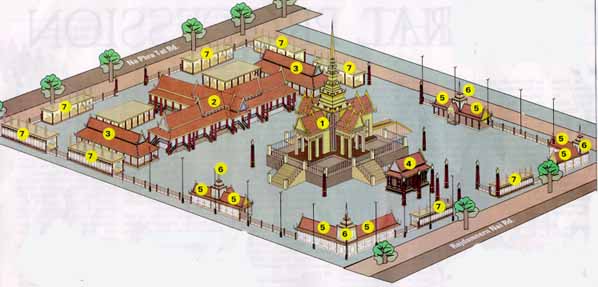
1. Merumas : Royal Crematorium. | 2.Phra Thinang Songtham : Royal Pavillion for their Majesties the King and the Queen , the royal Family and top officials | 3. Sala Luk Khun : Pavilions for government officials. | 4. Ho Pluang : the outer Royal Golden Urn will be removed here. | 5. Sala Thab Kaset : pavilions for officials. | 6. Sang : pavilions where monks will chant scriptures and prayers | Note : The lower left side of the diagram faces the Grand Palace. Wat Mahathat is across Na Pra That Road at upper left. Toward the upper right is the outer part of Sanam Luang
When the main procession approaches the Merumas, or Royal Crematorium, it will halt at the northern gateway. The Royal Urn will be lowered from the Great Funeral Chariot onto the threepoled palanquin by means of a ramp. A new, smaller royal procession will then be formed. The revered monk will lead the procession on a palanquin, reading chapters from the Abhidharma scriptures.
Their Majesties the Mng and Queen, Crown Prince Maha Vajiralongkorn and Princess Maha Chakri Sirindhorn will follow the Royal Urn on foot, circumambulating the Merumas in a counter-clockwise direction three times. At the end of the third circumambulation, the gilded threepoled palanquin will halt at the ramp that leads up to the Royal Crematorium. A court attendant will pay homage to the Royal Remains before moving the Royal Urn from the palanquin to the ramp.
The Royal Urn will then be drawn by pulleys to the funeral pyre in the Merumas. The ornate outer covering will be removed in the Ho Pluang, located next to the Royal Crematorium, and the carved-sandalwood urn placed on the pyre, which will be hung with floral curtains.
From noon onwards, the crowd attending the ceremony at Sanam
Luang will be allowed to lay sandalwood flowers at eight spots
set around the field. Meanwhile, thirty-eight temples in Bangkok
and others throughout the country will hold sandalwood
flower-laying ceremonies at the same time.
At 4.30 p.m., Their Majesties the King and Queen will light the fire for the symbolic cremation, while the actual cremation will begin at 10 p.m., presided over by Their Majesties.
Many modern-day viewers of this centuries-old traditional ceremony may have little understanding of the meaning behind the various aspects of the ceremony, apart from the spectacle it offers.
The Royal Cremation Ceremony, like many other ceremonies in Thailand, is a blend between Brahmin and Buddhist practices.
The ancient Khmer tradition inherited by the Thai Kingdom from pre-Bangkok days holds that a King is an incarnation on earth of Siva,the great Hindu God.
Accordingly, upon his demise he is bid a farewell appropriate to a divine being. The body is dressed like a deity, encased in a special urn called Phra Koss, and raised high to reach the heavens.The high pedestal upon which Phra Koss is placed is called in Thai Phra Merumas, more commonly known as Phra Mane Thong, meaning "golden crematorium". This according to Hindu-Buddhist cosmology, is symbolic of the golden abode of the gods on the top of Mount Sumer-u.
It is believed that the word meru was probably derived from the original shape of the structure,made to resemble Mount Sumeru, including the supposition that Mount Sumeru was surrounded by smaller mountains at the four cardinal points of the compass.
Sanam Luang has been a place of central importance for the Thai people for centuries. Sanam Luang is Thai for "royal ground", and it is a place where the King performs state ceremonies.
In the past, Sanam Luang was an open field located between the Grand Palace and the Palace of the Second King. It has been used as a site for the cremation of kings, queens and nobility since the reign of King Rama 1. For this reason, in former times it was officially known as Thong Phra Meru (cremation ground).
During the reign of King Rama III, when Thailand was engaged in a conflict with Vietnam, the King wished to demonstrate to other nations that Thailand was such a fertile, flourishing country that even the area in front of the Grand Palace was cultivated. Sanam Luang was then a normal plot of land, used for growing rice. When there was a Royal Funeral, it would be smoothed over to prepare for the event.
During the reign of King Rama IV, when the ground was still used for farming, King Rama IV changed its official name from Thong Phra Meru to Thung Sanam Luang.
Sanam Luang has been used as the cremation ground for all of Thailand's kings and Royal Family members except for King Rama VII, who died in England. The most recent cremation rite to be held there was for Queen Rambhai Barni, in 1986.
Materials from Bangkok Post